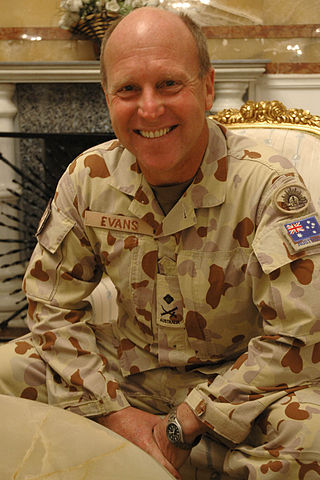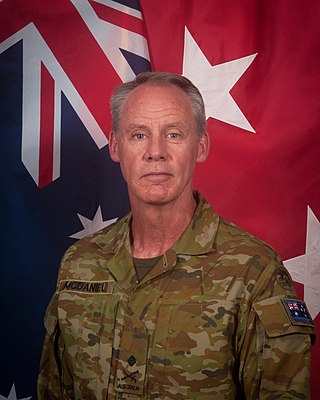
The Royal Australian Regiment (RAR) is the parent administrative regiment for regular infantry battalions of the Australian Army and is the senior infantry regiment of the Royal Australian Infantry Corps. It was originally formed in 1948 as a three battalion regiment; however, since then its size has fluctuated as battalions have been raised, amalgamated or disbanded in accordance with the Australian government's strategic requirements. Currently, the regiment consists of seven battalions and has fulfilled various roles including those of light, parachute, motorised and mechanised infantry. Throughout its existence, units of the Royal Australian Regiment have deployed on operations in Japan, Korea, Malaya, Borneo, Vietnam, Somalia, Rwanda, Cambodia, East Timor, the Solomon Islands, Iraq and Afghanistan.

6th Battalion, Royal Australian Regiment is a mechanised infantry battalion of the Australian Army. It was originally raised in Brisbane, Queensland, on 6 June 1965 and has since then served in a number of overseas deployments and conflicts including South Vietnam, East Timor, Iraq and Afghanistan. During the Vietnam War, the battalion earned a US Presidential Unit Citation from the United States when members from 'D' Company participated in the Battle of Long Tan on 18–19 August 1966. The battalion is currently based at Gallipoli Barracks in Brisbane and forms part of the 7th Brigade.

The 3rd Brigade is a combined arms brigade of the Australian Army, principally made up of the 1st and 3rd Battalions of the Royal Australian Regiment. Initially raised in 1903 as part of the post-Federation Australian Army, it was removed from the order of battle in 1906 following the restructure of the field force. It was re-formed in 1914 for service during World War I, taking part in the fighting at Gallipoli and on the Western Front in Europe. During World War II the brigade was used in a defensive role before it was disbanded in 1944. It was re-raised in 1967 for service during the Vietnam War and later went on to provide the nucleus of the deployment to East Timor during the Australian-led intervention in 1999. The brigade is currently based at Lavarack Barracks in Townsville, Queensland.

The 3rd Battalion, Royal Australian Regiment is the armoured infantry battalion of the Australian Army, based in Kapyong Lines, Townsville as part of the 3rd Brigade. 3 RAR traces its lineage to 1945 and has seen operational service in Japan, Korea, Malaya, Borneo, South Vietnam, Rifle Company Butterworth, East Timor, the Solomon Islands, Afghanistan, and Iraq.

1st Battalion, Royal Australian Regiment is a regular motorised infantry battalion of the Australian Army. 1 RAR was first formed as the 65th Australian Infantry Battalion of the 34th Brigade (Australia) on Balikpapan in 1945 and since then has been deployed on active service during the Korean War, the Malayan Emergency, the Vietnam War, Unified Task Force in Somalia, East Timor, Iraq War and Afghanistan. Additionally, the battalion has deployed on peacekeeping and other operations to a number of countries including Japan, Rifle Company Butterworth, Timor Leste, Solomon Islands, Tonga and the Philippines. 1 RAR remains one of the Australian Army's most readily deployed units sending individuals and detachments to domestic, regional and other enduring operations. The battalion is currently based in Coral Lines at Lavarack Barracks, Townsville, Queensland, where it forms part of the 3rd Brigade.

The 8th/9th Battalion, Royal Australian Regiment is a motorised infantry battalion of the Australian Army. It was originally formed in 1973 by linking together both the 8th and 9th Battalions of the Royal Australian Regiment. Over the next twenty-four years the battalion would remain on the Australian Order of Battle based at Enoggera Barracks in Brisbane, Queensland, until it was disbanded in 1997 amid a number of Defence-wide cutbacks introduced by the Howard government. In 2006 it was announced that the battalion would be re-raised as part of a plan to expand the size of the Army and since then it established itself as a fully deployable motorised infantry battalion as part of 7th Brigade.

The 5th Battalion, Royal Australian Regiment was a regular motorised infantry battalion of the Australian Army. Originally established in 1965 it would serve two tours of South Vietnam before it was linked with the 7th Battalion to form the 5th/7th Battalion, Royal Australian Regiment in 1973. In late 2006 the two units were de-linked, and 5 RAR again joined the Australian Army's order of battle in its own right. It has since served in Iraq, East Timor and Afghanistan. The battalion was re-merged with the 7th Battalion to reform the 5th/7th Battalion, Royal Australian Regiment in 2024.

The 7th Battalion, Royal Australian Regiment was a regular infantry battalion of the Australian Army. It was originally raised in 1965 as part of Australia's commitment to the Vietnam War and it eventually served two tours in Vietnam in 1967 and 1971. In 1973, following Australia's withdrawal from the conflict, the battalion was amalgamated with the 5th Battalion, Royal Australian Regiment to form the 5th/7th Battalion, Royal Australian Regiment. The battalion was re-linked with the 5th Battalion to reraise the 5th/7th Battalion, Royal Australian Regiment in December 2024.

Lieutenant General Mark Evans, is a retired senior officer in the Australian Army. He was chief of joint operations from July 2008 until his retirement in May 2011.
Major General Michael Simon Hindmarsh is an Australian-Emirati Major General who is the current president of Zayed Military University (ZMU) in Abu Dhabi, United Arab Emirates.

Major General Mark Andrew Kelly, is a former senior officer in the Australian Army. He served as Commander Joint Task Force 633 commanding all Australian Forces in the Middle East Area of Operations and Afghanistan from 12 January 2009 until 14 January 2010, and as Land Commander Australia from July 2005 to December 2008. He was appointed as the Repatriation Commissioner on 1 July 2010 and served in that role until 30 June 2019.

Major General Richard Gary Wilson, AO is a retired senior officer of the Australian Army. He served as Director of the Defence Intelligence Organisation from 2009 to 2011, and Chairman of the Queensland Reconstruction Authority in the wake of the 2010–11 Queensland floods.

The 2nd Commando Regiment is a special forces unit of the Australian Army and is part of Special Operations Command. The regiment was established on 19 June 2009 when the 4th Battalion RAR (Commando) was renamed. It is based at Holsworthy, New South Wales. The 2nd Commando Regiment trains and has served with coalition special forces units, and is highly regarded by these units. The regiment has been involved in operations in East Timor, Iraq and Afghanistan, where it was used in a direct action warfighting role. It has also been involved in domestic security operations including the 2006 Commonwealth Games and the 2014 G20 Leaders Summit. The regiment is the Command's capability lead for strike and recovery.

Lieutenant General John Graham Caligari, is a retired senior officer of the Australian Army. He served as Chief Capability Development Group from October 2014 until his retirement in August 2015.

Major General Stuart Lyle Smith, is a retired senior officer of the Australian Army. He commanded the 1st Division from October 2012 until November 2015, when he was appointed Deputy Chief of Joint Operations.

Major General Daniel Francis McDaniel, is a retired senior officer of the Australian Army. He served as the acting Special Operations Commander Australia from September 2013 to December 2014, after Major General Gus Gilmore was reassigned. He was seconded to the United States Army Pacific as Deputy Commanding General – North from January 2019 to January 2022.

Lieutenant General John James Frewen, is a retired senior officer of the Australian Army. He joined the army via the Royal Military College, Duntroon and was commissioned into the Royal Australian Infantry Corps in 1986. He has commanded the 2nd Battalion, Royal Australian Regiment (2003–04), Combined Task Force 635 (2003), the 1st Brigade (2012–14), Military Strategic Commitments Division (2014–16) and Joint Task Force 633 (2017–18), and deployed on operations to Rwanda, the Solomon Islands and Afghanistan. He was appointed Principal Deputy Director-General of the Australian Signals Directorate in March 2018, and Coordinator General of the National COVID Vaccine Taskforce in June 2021. He was Chief of Joint Capabilities from September 2021 to July 2024.

Major General Christopher Antony Field, is a retired senior officer of the Australian Army. He joined the army via the Australian Defence Force Academy in 1984 and was commissioned into the Royal Australian Infantry Corps. He has commanded the 1st Battalion, Royal Australian Regiment (2003–05), Combined Joint Task Force 635 (2004–05) and the 3rd Brigade (2015–17), coordinated reconstruction efforts in Queensland in the wake of the 2010–11 Queensland floods and Cyclone Debbie, and deployed on operations to East Timor, Iraq, the Solomon Islands and Afghanistan. He was Commander Forces Command from June 2019 to February 2020, Deputy Commanding General – Operations for United States Army Central from March 2020 to November 2021, and was Assistant to the Chief of the Defence Force from 2022 until his retirement in 2023.
Major General Jeffery John Sengelman, is a retired senior officer of the Australian Army. He joined the army via the Officer Cadet School, Portsea in 1980, was commissioned into the Royal Australian Infantry Corps and spent much of his military career in special forces. He commanded the 4th Battalion, Royal Australian Regiment (Commando) (2000–01) and the 6th Brigade (2010–11), deployed on operations to East Timor and Iraq, and served as Commander Forces Command in 2011, Deputy Chief of Army from 2011 to 2012, Head of Modernisation and Strategic Planning – Army from 2012 to 2014, and Special Operations Commander Australia from 2014 until his retirement in 2017.

Major General Justin Frederick Ellwood,, commonly known as Jake Ellwood, is a retired senior officer of the Australian Army. He joined the army via the Royal Military College, Duntroon in 1989 and was commissioned into the Royal Australian Infantry Corps. He commanded the 5th Battalion, Royal Australian Regiment (2006–08), Overwatch Battle Group (West) (2007), Battle Group Tiger (2008) and the Combat Training Centre, and deployed on operations to Kosovo, East Timor, Iraq and Afghanistan. He served as Deputy Chief of Army from May to December 2018, and commanded the 1st Division from December 2018 to November 2021.
















